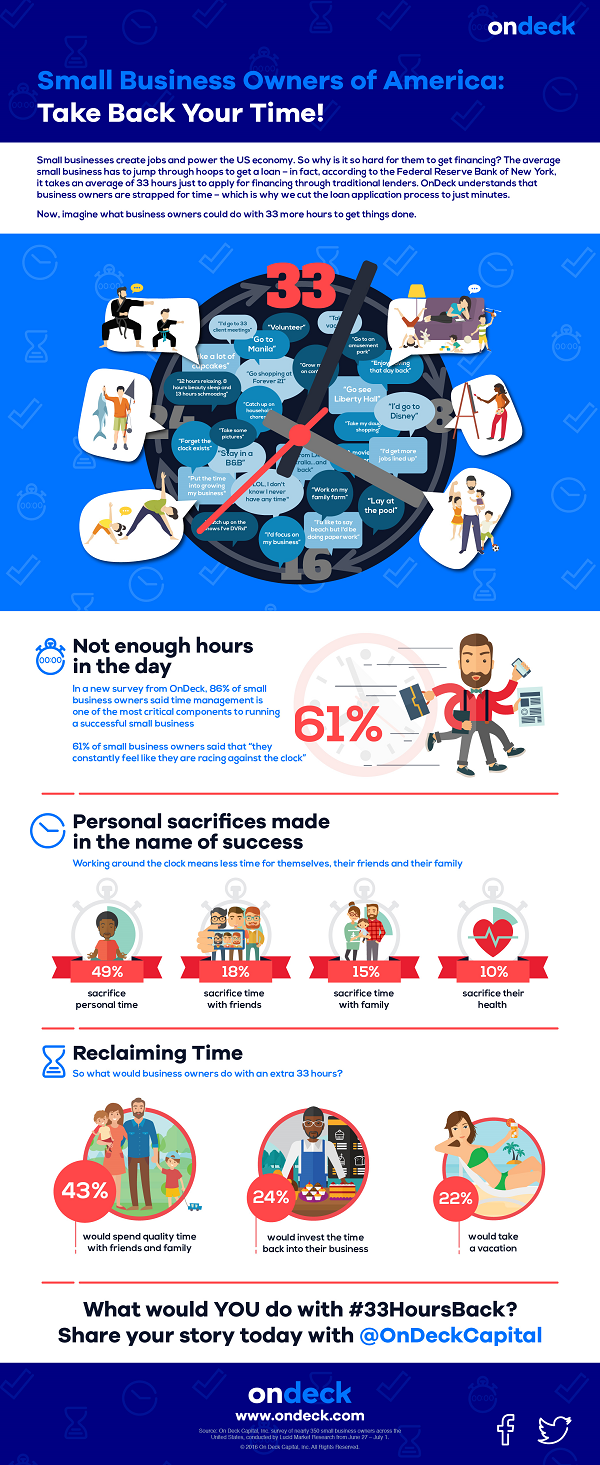11 Things Entrepreneurs Need to Know
By Rieva Lesonsky
1—Internet in Real Time
This is just fascinating. You can actually see what’s happening online—as it happens. In 10 seconds I watched as Twitter went from 1,800 tweets to more than 77,000.

powered by Betfy.co.uk
2—The Triumphs and Trials of Small Business Ownership
OnDeck, a leading online lender for small business, launched a national initiative to help small business owners overcome one of their most formidable challenges—time management. The initiative is in response to OnDeck’s latest Main Street Pulse Report, a quarterly study of small business trends, which found that many small business owners are more pressed for time than ever before, with a whopping 86% of those surveyed saying that “one needs to be exceptional at time management to excel as a small business owner.”
The Main Street Pulse Report highlights a challenging reality for small business owner with half agreeing that “as a business owner, work/life balance is an illusion” and 61% saying “they constantly feel like they are racing against the clock.” When asked, “How many hours per week would you need to successfully run your business?” those surveyed say it would take 69 hours on average.
Some key findings include:
- A typical work week for small business owners clocks in at 48 hours and yet 31% feel there isn’t enough time in the week to devote to their businesses.
- 86% believe, “To be a business owner, you have to be exceptional at time management.”
- Small business owners spend the most time on their business during the Summer (44%) followed by Winter (24%), Spring (20%) and Fall (13%).
One key pain point for small business owners is accessing capital to help their businesses grow. According to the Federal Reserve Bank of New York, small business owners spend 33 hours, on average, applying for credit.
In fact, time is so precious to them 30% would pay $1,000 or more to get that 33 hours of time back.
When asked, “If you had an extra set of hands at work, how would you utilize them ?”small business owners say they need help with:
- Administrative work (i.e. filing paperwork) (33%)
- Answering phone call and greeting customers (18%)
- Running social media accounts (15%)
Check out the video showing what else small business owners could do if they had those 33 hours of time back.
To learn more about the 2016 Small Business Time Management Initiatives go to Facebook.com/OnDeckCapital.
To see more, take a look at the infographic below.

3—Finding the Best Location
When your business is growing, selecting a new location to expand is one of the biggest and most important decisions you’re going to face—due to the serious long-term impact it will have on your small business.
Jim Robeson, cofounder and CEO of PiinPoint, a location analytics platform that utilizes big data to help businesses discover, validate and add locations, says small business owners should ask themselves these questions before choosing a new location:
- Who is your target customer? Combining demographics such as median income, education level or population in a set age range are the best way to help identify and locate your target market.
- What factors will drive traffic to the site? Understand the anchors (any high-traffic location that serves as a focal point, such as a sports arena) and complementary brands (a particular type of business or a specific brand that is either, used in conjunction with your product or service, or improves its experience) that are nearby.
- What risks and opportunities are there around the site? Research the history of the location, as well as the future of the area around it, such as an up-and-coming neighborhood where modern buildings and increased population will soon be. Likewise, be aware of construction and road closures that can interfere with your sales.
4—IT Efficiency
The folks at Permabit believe, “Widespread adoption of cloud computing has ushered in a new age of IT efficiency. Efficiency in the cloud is driven by major trends, such as virtualization, open source, white box hardware, and data reduction technologies, including deduplication, compression, and thin provisioning.
Cloud data centers are driving high density computing to its physical and electrical limits. As data centers approach density limits, the need for robust data reduction becomes a requirement. Permabit data reduction uniquely optimizes storage density and network utilization, enabling you to store at least 4 times as much data in existing data centers and lower the TCO of your Linux cloud environment.”
Check out the infographic below for more insight.

Brought to you by:Permabit.com
5—The True Cost of Employees
How much do your employees really cost you? The folks at eaHELP, a company that matches businesses with virtual assistants gives us the scoop in the infographic below.

6—What’s Holding You Back from Being a Great Leader?
Guest post by Rosalie Chamberlain, the owner of Rosalie Chamberlain Consulting & Coaching and the author of the new book, Conscious Leadership in the Workplace: A Guidebook to Making a Difference One Person at a Time.
Fear that underlies bias about others can show up in ways we might not expect. It can show up in the individual who wants to succeed but holds themselves back because of fear, and it can show up in the leader who cannot see the talent that is right before them because there is too much focus on what/who is comfortable. The sense of discomfort or difficulty and our emotional reaction to that discomfort is the trigger process we are looking for.
Triggers show up in our emotional reactions. They do not always look like fear, though I believe a kind of subtle fear is at the root of each one of our triggers. If we have done some work on our unconscious biases, it may be helpful to review what we’ve discovered. Protecting ourselves from fearful situations is only natural. Our built-in desire for safety comes from a long ago evolutionary time when human beings had to be defended and reactive against the real dangers to their physical existence. There was no time to ponder. For survival, the reactions needed to occur instantaneously without lengthy thought.
However, these days our fight or flight instinct is overused and overworked and not always in proportion to its natural, instinctual purpose to protect us from truly harmful situations. We do experience—or our brains interpret experiences as—threats to our sense of well-being, to our sense of self, to our sense of success. Whether perceived or real, this “threat” brings on the same reactions. In order to become more thoughtful leaders, we need to grow in awareness of the difference between real bodily harm and perceived personal threats of a less existential kind.
Triggers are important to be aware of because triggers and fears become habits. The more we allow them to operate below our full conscious awareness, the less power we have to change them or to create a different outcome based on more beneficial insights and habits. Just as with our unconscious biases, triggers can cause us to miss valuable opportunities. If we are triggered to react emotionally to our colleagues and team members, we may overlook the ways we can support each other’s success. We have a choice to proceed differently, but often don’t recognize it. Our realities will become (or remain) governed by these triggers. Even if you do not know what it is, others could interpret the message as unwelcoming and implying disinterest.
For instance, biases can be either a bias for or a bias against something or someone. Reactions to a bias can manifest as tension, anxiety, frustration, uncertainty and even anger. These body sensations are connected to what our mind is thinking or perceiving even when we are not conscious of those thoughts. We just feel the need to protect or defend. If you recognize an emotional reaction to someone or to their opinion, notice what body language is taking place in you. You may want to roll your eyes, disengage or turn away. It could be that you are aware of the reaction and prefer to put on a face that is bland, sort of a poker face. While a poker face may seem like a neutral expression, it is a mask to cover up what is really going on. Question if you have intolerance, dislike or bias about the other person’s perspective or way of being. This is not inclusion. This is exclusion of different perspectives. Being open to listening to other perspectives does not mean that you have to agree. How much can it hurt to be open to really listening? How much might it help?
I am a firm believer that our thoughts create our realities. We can change our reality by focusing on our thoughts and making changes in them that can produce a more productive outcome. If you approach fears and triggers with a mindset of curiosity, you will be better able to set judgment aside and discover new possibilities. Remember to proceed with self-kindness and acceptance, as you create a dialogue with your unconscious biases. Self-judgment is another emotional reaction that can be triggered by fear of the unknown. Judgment, in this context, is not useful to us. Non-judgment is a key piece because it is a state of being that provides us the opportunity to consciously observe situations. Have a curious mindset about where the judgment of self or others comes from. We will always have more time for discernment when it is necessary. But for now, we are on a fact-finding mission: what triggers influence our decision-making?
A powerful partner in the way our thoughts create our realities is language. Begin to listen to language—yours and the language of others. Notice if you use words like “hate,” “don’t like,” “crazy busy,” etc. My clients are amazed at how their energy and perspective shifts when they recognize language that has a negative tone. Our words help create our reality and empowering words have an amazing impact on that reality. You can generate positive changes in yourself and in others simply by paying attention to the words you use. Words can trigger negativity. It’s likely you have had the experience of reacting emotionally to what someone else has said. What words trigger your hot buttons? What do others say and do that trip your emotional trigger? In order to grow in conscious awareness, we have to know what our triggers are and be aware of what happens to us when a trigger occurs. The next time one of your triggers is tripped, explore the following questions:
- What is happening to my energy?
- Where is my focus?
- What can I do to get back on track, get grounded or centered?
- What motivates me and what de-motivates me?
For instance, if you get off track on a goal or action because something did not go quite the way you anticipated it would; do you give up, beat yourself up, complain about the situation or the others involved, and create a vicious cycle that keeps you running on a hamster wheel? Our reaction to triggers happens instantaneously.
As you work more deeply on your awareness about triggers and their effects, remember to take a breath and slow down. By slowing down and learning about the trigger and your defensive emotional reaction, you have a better chance of ending these types of internal struggles. You benefit, and so do those you lead.
Try the following exercise to help identify your triggers:
- Identify a challenge you see and experience in your world.
- What are the perspectives that are learned and the ones that are habitual? List these.
- List alternative perspectives to approach the perceived challenge. Once you examine other perspectives, what might be another way of looking at the challenge or situation?
7—5 Tips to Help Women Improve Their Leadership Skills
Merrick Rosenberg, personality expert, author and TED Talk speaker has some advice for women to help women improve their leadership skills.
- Be assertive but not aggressive. Demonstrate conviction in your beliefs and act with confidence. Speak with certitude while conveying openness to the ideas and opinions of others.
- Embody enthusiasm. Everything you do should reveal your passion and commitment to the mission and goals of the company. The people around you should feel that you love what you do.
- Demonstrate compassion. Be authentic and understanding of others. Don’t assume kindness reveals weakness.
- Insist on performance. Be accepting of the people around you, but don’t tolerate poor performance or a failure of others to be respectful. Hold people accountable for what they say and commit to doing.
- Stand in your power. Don’t allow others to cut you off or talk over you. If you have something to say, make sure it’s heard.
- Balance home relationships to stay centered at work. Women often take on more of the workload at home, which can create a burnout in the workplace. Make sure that you have time to recharge your batteries by making time for yourself.
8—The Reason Businesses are Losing Employees
A global survey of business executives, managers and analysts shows more than 50% of employees at less digitally developed companies are planning to quit in less than three years. In fact, according to MIT Sloan Management Review and Deloitte Digital’s 5th annual Digital Business Study, Aligning the Organization for Digital Success, approximately 30% of SVPs, VPs and director-level leaders expect to depart their company in less than one year because they do not have adequate access to resources and opportunities to develop and thrive in a digital environment.
Some key findings include:
Digitally maturing organizations place a decisive emphasis on recruiting and developing their workforces:
- More than 75% of these organizations provide their employees with resources and opportunities to develop their digital acumen compared to only 14% of digitally early stage companies
- In addition, 71% of digitally maturing companies are able to attract new talent based on their use of digital technologies, while only 10% of their early stage peers can
Soft skills trump technology knowledge in driving digital transformation:
- Only 18% of respondents listed technological skills as most important
The skills needed to lead companies in the digital era include:
- Having a transformative vision (22%)
- Being a forward thinker (20%)
- Having a change-oriented mindset (18%) or other leadership and collaborative skills (22%)
Creating an effective digital culture is an intentional effort:
- Nearly 80% of respondents from digitally maturing entities indicate their companies are actively engaged in initiatives that bolster risk taking, agility and collaboration
- For early stage companies, the number falls to 23%
- More than 75% of digitally maturing organizations provide their employees with resources and opportunities to develop digital acumen compared to only 14% of early-stage companies
9—Field Guide to Business Startup
Small business insurance provider Hiscox has 6 startup tips for aspiring business owners:
- Define your business: Ask yourself, what is my product or service? Define its features as specifically as you can. Rather than saying, “My business is a housecleaning service,” you might say, “I clean the interiors of houses, including bathrooms, kitchens, bedrooms and living spaces. I vacuum, dust, clean sinks and fixtures, shampoo rugs and clean walls and baseboards.”
Next, determine why someone would pay money for your product or service. What are the benefits? For a housecleaning business, the benefits would be your customers will have a clean and comfortable house to live in, and will have more time to spend with their families.
- Look at the competition: There are two kinds of competition—direct competition and share-of-wallet competition. Direct competition includes other companies that provide the same product or service that you do. For these competitors, look at their business model and see how you can improve on it. Look at their pricing and their service delivery. If you can, go ‘undercover’ to a competitor to see how their business works. Look at their online reviews to see what people like and don’t like about them.
Even if your product or service is truly unique, you still have competition. Unless your potential customer is a gazillionaire, they have to make choices about how they spend their money, so even a unique product competes for the customer’s discretionary income. Think about the things people might spend their money on instead of your product or service. In the case of the housecleaning business, people may choose the clean their homes themselves and use the money they save to go on a family vacation, for example.
- Logistics: Decide on the structure you want your business to have. If you know you will be working alone, and have no plans to hire any employees, a sole proprietorship may be the simplest structure to use. Two or more owners may choose to form a partnership. A sole proprietorship and a general partnership are pass-through entities, meaning that any income from the business passes through to the owners. The business itself pays no taxes, but the owners do. A corporation is a separate entity, so it pays taxes on the income earned. When the corporation pays wages, those are taxable again to the employee. This double-taxation discourages a lot of people from forming a corporation, but this structure can provide some protection from liability for the owners. Consult a tax accountant for advice on the best structure for your business.
Get an Employer Identification Number from the IRS. If your business is located in New York, South Carolina or Massachusetts, you also need to register with the state. Check with your local municipality to see if you need a local license or permit to do business.
If you have invented a product that you plan to market, consider obtaining a patent for it. This will prevent others from copying your design and profiting from your idea. You can learn more about patents from the US Patent and Trademark Office.
Nearly every business needs insurance. The type and amount will depend on the type of business you have, but liability insurance will protect you in the event you are sued for negligence, bodily injury, property damage, discrimination, or any number of other things. Some startups will try to save money by foregoing insurance, but that can be very unwise. A lawsuit can be expensive, even if you are found not to be at fault.
- Get the word out: Now that you know what you need to do in order to start your business, you need to let potential customers know about it. That’s where a marketing plan comes in.
Since you’ve done your market research, you know who your customer is and who your competition is. Use this information when you create your marketing plan.
Many people think that marketing and advertising are the same thing. In fact, marketing encompasses advertising, but it’s much more. It also includes things like pricing, packaging and distribution. It’s the end-to-end process that gets your product from your warehouse into the customer’s hands.
People need to know about your product before they can buy it, and that’s where advertising comes in. Advertising used to be the single biggest expense related to a new business, but now you can get the word out about your product or service for next to nothing.
Start with a website that’s optimized for search and mobile. Add social media and focus on increasing your followers. Once your online presence is up and running, do some homegrown public relations. Start with your local media by sending an email to the editor of your town or city newspaper. They’re often looking for stories to fill their pages, and if something newsworthy lands on their desk, they’re usually more than happy to print it. ‘Newsworthy’ is the operative phrase here. You can’t just promote your business; what you’re saying needs to be considered news.
- Pricing: Pricing is critical, because it can mean the difference between a successful business and one that closes its doors after a year. There are two ways to set your price. The first is to look at competing products and determine what the market will bear, and then figuring out how to provide your product and service so that you can sell it at the market price and still make a profit. The other way is cost-plus pricing, where you add up how much it costs you to make your product, then add on a profit, and that determines your price.
Your marketing strategy can also be a factor in your pricing. If you plan to market your product as a luxury brand, you can charge more per unit if you’re willing to sell fewer units. If you opt for a mass market strategy, you’ll price your product lower and make it up with volume.
- Packaging and Distribution: Packaging is a function of marketing because you should design your packaging to help you sell product, particularly if you’re selling at retail. But there are ‘packaging’ decisions to be made even if you’re selling a service, such as whether to break out certain features into add-on purchases.
Distribution determines how you physically get your offering to your customers. You may deliver it directly, in the case of a service. Or, you may ship a product direct, or go through wholesalers to get into retail. Your distribution method will impact your pricing and your margins, so consider this carefully.
This may sound like a lot to do before you even open your doors. But planning in advance and considering all of these things will give your business the best chance of success.
10—Making the Platform Economy Big and Hard to Miss
Guest post by Kurt Bilafer, Global Vice President Sales & Success at WePay
“Why did WePay wrap a train car?” I’ve been getting that question a lot lately. Actually we wrapped two Caltrain cars that shuttle daily between San Francisco and San Jose. Maybe you’ve seen one of them—they’re big and blue and bear the logos of WePay and our customers.
This is one element of a campaign to start a conversation about the rapidly emerging platform economy. Business platforms such as eBay, Uber, Etsy, Airbnb—sometimes also called multi-sided marketplaces—are transforming the economy. Many of our customers are part of this movement.
There’s a lot of talk in business academia right now about the economic benefits of platform companies, and how they differ from traditional companies. There is a lot of buzz about platforms among the technorati in Silicon Valley, but I still don’t think there’s a clear understanding of what platforms are, how businesses can make the shift from product or service to platform, and what sort of impact platforms are going to have on business overall.
Matchmaking plus
So what is a platform? At a basic level, it’s a business that generates value from enabling interactions and transactions between two or more parties.
But there’s a little bit more to it than that. Successful platforms provide operational efficiency and improvements over a current process. It isn’t just matchmaking. There are also value added services that enrich the experience, and keep customers coming back.
Payments is one of those services, but it could be loans, or integrations with marketing automation or CRM solutions, or anything adjacent to the core offering that makes it easier for people do business together.
Why does WePay care about the platform economy? We specialize in providing integrated payment services for platforms.
This is still a new category of payments. The way payments have historically been handled online was ported over from the bricks-and-mortar world. It’s never worked great for e-commerce transactions between one buyer and one seller. It gets even clunkier when you have three parties involved in a payment transaction—the seller, the buyer and the matchmaking platform.
If you’re a platform, understanding who’s the merchant of record, who’s responsible for risk, how money gets moved around, and who has visibility into those transactions all come into play. Integrated payments help platforms handle all those things seamlessly in one package.
Do you platform?
The thing is, a lot of our potential customers don’t recognize that they’re a platform or on their way to becoming one. And even if they do, they’re new to taking payments and don’t understand why the payment solutions that work for two-party transactions don’t work well at all for platforms. And they don’t know about integrated payments, which are a much better alternative.
Selfishly, if we can help companies understand the benefits of being a platform and how to think like a platform, they’ll also understand that we offer one of the few solutions that can meet their needs.
But it’s not entirely selfish.
One of the things I like about the payments business is that our success is so directly tied to our customers’ success. Our piece of the platform opportunity is just a small one. There’s a lot of opportunity out there for a lot of different types of companies.
Software products vs. platforms
One of the biggest opportunities is in software. Many of our existing customers, including Constant Contact, FreshBooks, Infusionsoft and BuilderTrend, are software companies that have successfully made the shift from product company to platform.
One of my favorite examples of platform vs. product is in the CRM (customer relationship management) space. Salesforce.com, the market leader, is a platform. It offers an API for people to build on, along with documentation and guidelines to help them. There’s an app exchange with solutions that can integrate everything from web analytics to order payment into Salesforce.com. It makes for a very sticky platform.
Competitor SugarCRM on the other hand, is focused on being a best-of-breed solution. There are a few third-party apps, but no platform vision. It might have some superior functionality, but the extensibility of Salesforce.com makes it more compelling.
As platforms rise to dominance, product vs. platform is something that ISVs (independent software vendors) and SaaS (software as a service) companies should be thinking about. During the six-month window that the trains run, there will be people from a lot of software companies coming to the Bay Area to attend events such as NetSuite’s SuiteWorld, Salesforce.com’s Dreamforce, and Oracle Open World, to name a few of the big ones. We hope the train car will get them thinking.
But this is also something that software buyers should be thinking about.
When you look at our customer logos on the train, such as Zoho, Infusionsoft and FreshBooks, you probably don’t immediately think ‘platform.’ People think of these as cloud CRM, marketing automation and accounting solutions respectively.
But not all solutions in these categories are created equal. Those that are embracing the platform mindset and methodology are continually adding more value for their customers by building or partnering to add adjacent capabilities or processes. If you pick a best-of-breed solution that does just one thing, you may end up having to manage five or ten different solutions to provide the same functionality that one platform may ultimately provide.
The train car wrap is just one part of our effort. Earlier this summer, we had an Influencer Summit bringing together economists doing research on the platform economy, tech influencers, and customer companies that have made the journey from product company to platform company. We also launched DoYouPlatform.com, where we’re going to have customers and thought leaders share lessons learned to help them figure out how to platform—and take payments—properly, and sooner rather than later.
The platform economy and understanding of it is still emerging. By most predictions it’s going to be big. We’re doing our part to make sure it’s not only big, but hard to miss. Kind of like a train car.

Cool Tools
11—Top Tools for Small Businesses
What are your favorite small business tools? In SurePayroll’s recently released 3rd annual favorite tech tools survey, small business owners rank their favorite tech tools and apps.
Here are some highlights from the survey:
- Cloud storage: Google Drive
- Email marketing software: Mail Chimp
- Organization app: Google Drive
- Social network: Facebook
- Social media management: Hootsuite
- CRM: Salesforce
The full rankings of small business owners’ favorite tech tools is available on the SurePayroll Facebook page.







